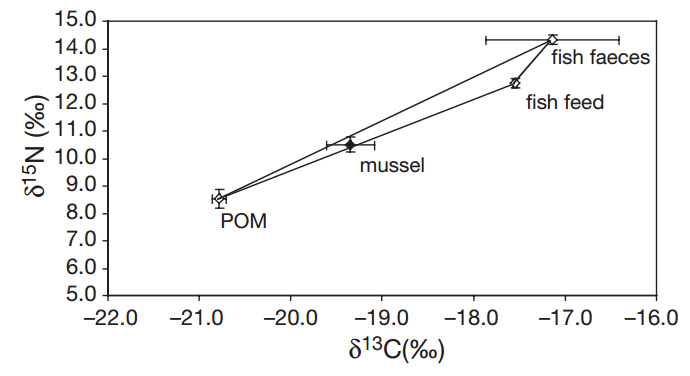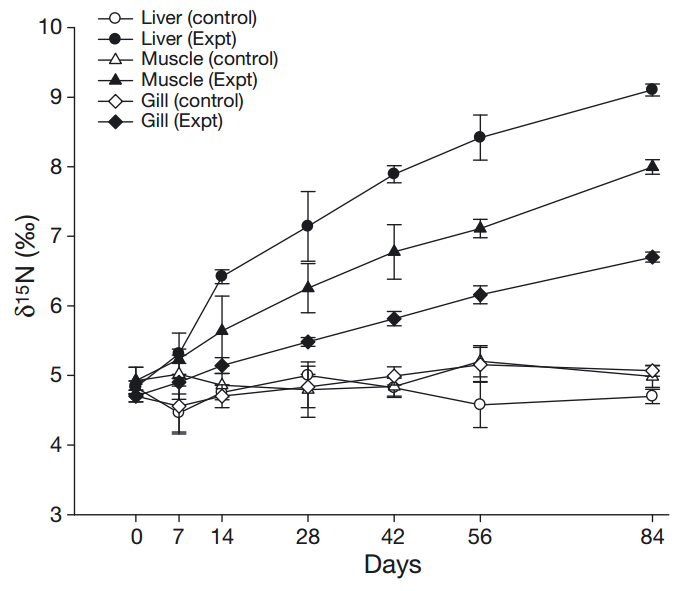
Associate Professor, Supervisor of Master Study,
Laboratory of Aquaculture Ecology,
Department of Aquaculture, Fisheries College, Ocean University of China
5 Yushan Road, Phone: 86-532-82032435
Qingdao 266003, Fax: 86-532-82032435
P. R. China Email: qfgao@ouc.edu.cn
EDUCATION
Bachelor of Agronomy, Aquaculture, Ocean University of Qingdao, 1993
PhD, Marine Ecology, City University of Hong Kong, 2005
RESEARCH
Research Interests:
My research focuses on aquaculture ecology, especially stable isotope ecology in aquaculture waters, including food sources of economic aquaculture species, food web analysis of aquaculture ecosystems and nutrient fluxes in aquaculture waters.
Specific Research Fields
1. Removal of farming wastes by co-cultured species in polyculture systems: evidence from stable isotopes and fatty acids
Stable isotope and fatty acid evidence for uptake of organic wastes from fish farming by green mussels: To evaluate the feasibility and capability of filter-feeding bivalves as biofilters for organic wastes derived from fish faeces and feed wastage in marine fish culture activities, a polyculture system comprising fish and green-lipped mussels (Perna viridis) was developed by transplantation of mussels into fish cages. Mussels from the same population were simultaneously transplanted to a distant reference site free of effects from fish farming activities and acted as control. After 3-month’s acclimation, samples of mussel tissue, particulate organic matter, fish feed and fish faeces were collected for measurements of carbon and nitrogen isotopic ratios, and fatty acid profiles. Enrichment of 13C and 15N in mussel tissue collected inside the fish cages as compared to those at the reference site indicated the uptake and assimilation of isotopically heavier fish feed and fish faeces. Compared with the mussels at the reference site, the pattern of fatty acid profile and single fatty acid species of mussels in fish cages also tended to be closer to the fatty acid profile of fish feed from fish farms. Based on the concentration-weighted isotope mixing model, the proportions of mussel biomass assimilated from particulate organic matter, fish feed and fish faeces to mussel dietary consumption were 68.3%, 27.5% and 4.2%, respectively. The direct uptake of organic wastes from fish farms by filter-feeding mussels is different from the consumption of phytoplanktonic biomass as the nutrient flux is shifted between these two distinct pathways.

2. Stable isotope dynamics of aquaculture species
Turnover and fractionation of nitrogen stable isotope in tissues of grass carp with emphasis on the role of growth and metabolism: Determination of isotopic turnover rate in the various tissues of an organism is one of the essential prerequisites for tracing the food sources of consumers and for elucidating the trophic interactions in ecological studies using stable isotope analysis (SIA). Isotopic turnover and fractionation of the commercially important freshwater teleost grass carp Ctenopharyngodon idellus, however, are poorly understood so far. In the present study, we conducted a diet-switch experiment of C. idellus for three months to assess the nitrogen isotopic turnover and fractionation in different tissues of this species, including liver, muscle and gill. The results revealed that nitrogen isotopic turnover rates exhibited significant difference between tissues and increased in the sequence of gill < muscle < liver owing to the discrepancy in the metabolic activities between the tissues. The half-lives of nitrogen stable isotope turnover estimated with time- or growth-based models were, respectively, 29.9 days or 1.18-fold mass increase for liver, 68.3 days or and 1.45-fold mass increase for muscle and 115.4 days or 1.81-fold mass increase for gill. Nitrogen isotopic turnover of the grass carp was driven by both tissue replacement in the form of metabolism and net tissue increase in the form of growth. Metabolic contributions to nitrogen isotopic turnover reached approximately 70-77% for liver, whereas 86-90% contribution of growth to nitrogen isotopic turnover for gill suggested that, compared to metabolism, growth played more important role in the long-term isotopic turnover of gill with less metabolic activity. The nitrogen isotopic fractionation of all tissues was enriched by 3-4‰ relative to the nitrogen isotopic signature of the diet with significant difference between the 3 types of tissues probably owing to the different biochemical pathways and constituents between the various tissues.

3. Tracking of food sources for aquaculture species using stable isotopes
Seasonal changes in the food uptake by sea cucumber in the farming pond: Large-scale farming of sea cucumber Apostichopus japonicus has been developed in China in the last decades. On-site studies on the feeding behavior of this species in farming waters, however, are scarce so far. The present study investigated the seasonal changes in the C and N stable isotope values of the typical food sources of sea cucumber, including particulate organic matter (POM), macroalgae, benthic microalgae and animals such as nematode and copepod and quantified the relative contributions of the various items to the food uptake of sea cucumbers by means of stable isotope technique. The results showed the significant changes in the stable isotope values of the principal food sources due to the seasonality of the micro- or macroalgae prosperity and to the fluctuation in the environmental conditions. As a result, sea cucumber exhibited corresponding alteration in feeding strategy in response to the changes in food conditions. Calculation with stable isotope mixing model revealed that macroalgae was the principal food source for sea cucumber throughout the 1–yr investigation with the contribution proportion ranging from 28.1 % to 63.2 % on average while the average contributions of copepod and nematode, POM, benthic microalgae to the total food uptake of sea cucumber seasonally ranged from 22.6 ~ 39.1%, 6.3 ~ 22.2 %, 2.8 ~ 6.5 % and 2.8 ~ 4.2 %, respectively.

Research Projects
§ Productivity and utilization of epifaunal community on the artificial reefs in sea cucumber farming ponds, National Natural Science Foundation of China (Grant No. 30871931), 2009-2011 (PI);
§ Study on the biological and physiochemical processes of nutrient fluxes for sea cucumber-abalone polyculture system, National Natural Science Foundation of China (Grant No. 31172426), 2012-2015 (PI);
§ Technological optimization of the productivity and utilization of autochthonous nutritional elements in the farming pond of sea cucumber, National Natural Science Foundation of China (Grant No. 31372549), 2014-2017(PI);
§ Technological research and development of pollution control and clear production for aquaculture in high tidal zone, National Scientific and Technological Support Program for the 11th-plan period (Grant No. 2006BAD09A01), 2006-2010;
§ Optimization of biological functional groups and adjustment-control of aquatic environment for the ecosystems of aquaculture ponds, National Basic Research Priorities Program of China ('973' program) (Grant No. 2009CB118706), 2009-2014;
§ Study on the key techniques for effective and clean aquaculture in marine ponds, National Scientific and Technological Support Program for the 12th-plan period (Grant No. 2011BAD13B03), 2011-2015;
§ Technological research and demonstration for clean production and environmental safety in typical waters, Public Science and Technology Research Funds Projects of Ocean (Grant No. 200905020), 2009-2012
Honors:
§ 2011, Shandong Provincial Prize for Progress in Science and Technology;
§ 2011, New Century Excellent Talent Support Program, Education Ministry;
§ 2012, National Prize for Progress in Science and Technology;
§ 2013, Tiantai Prize for Excellent Talent awarded by Ocean University of China
PUBLICATION (*Correspondence)
§ Xia B, Gao QF*, Dong SL, Wang F, 2013. Carbon stable isotope turnover and fractionation ingrass carp Ctenopharyngodon idellatissues. Aquatic Biology, 19: 207–216
§ Xia B,Gao QF*, Li HM, Dong SL, Wang F, 2013. Turnover and fractionation of nitrogen stable isotopein tissues of grass carp Ctenopharyngodon idellus. Aquaculture Environment Interactions, 3: 177–186
§ Xia B,Gao QF*, Dong SL, Shin PKS, Wang F, 2013. Uptake of farming wastes by silver carpHypophthalmichthys molitrixinpolyculture ponds of grass carpCtenopharyngodon idella: Evidence fromC and N stable isotopic analysis. Aquaculture, 404-405: 8–14
§ Sun ZL,Gao QF*, Dong SL, et al., 2013.Seasonal changes in food uptake by the sea cucumber Apostichopus japonicus in a farm pond: Evidence from C and N stable isotopes. Journal Of Ocean University Of China 12: 160-168;
§ Sun ZL,Gao QF*, Dong SL, et al., 2012. Estimates of carbon turnover rates in the sea cucumber Apostichopus japonicus (Selenka) using stable isotope analysis: the role of metabolism and growth.MarineEcologyProgressSeries 457:101–112;
§ Gao QF*, Wang YS, Dong SL, Sun ZL, Wang F, 2011. Absorption of different food sources by sea cucumber Apostichopus japonicus (Selenka) (Echinodermata: Holothuroidea): Evidence from carbon stable isotope. Aquaculture319: 272-276;
§ Gao QF, Xu WZ, Liu XS, Cheung SG, Shin PKS*, 2008. Seasonal changes in C, N and P budgets of green-lipped mussels Perna viridis and removal of nutrients from fish farming. Marine Ecology Progress Series 353: 137-146;
§ Gao QF, Shin PKS, Xu WZ, Cheung SG*, 2008. Amelioration of marine farming impact on the benthic environment using artificial reefs as biofilters. Marine Pollution Bulletin 57: 652-661;
§ Wong WH, Gao QF, Cheung SG, Shin PKS*, 2008. Field observations on correlation of fatty acid profiles between suspended particulate matter and green-lipped mussels in subtropical waters. Marine Pollution Bulletin 57: 662–671;
§ Dahms HU*, Gao QF, et al., 2007. Optimized maintenance and larval production of the bryozoan Bugula neritina (Bugulidae: Gymnolaemata) in the laboratoryAquaculture 265: 169–175;
§ Cheung, SG; Gao, QF; Shin, PKS*, 2006. Energy maximization by selective feeding on tissues of the venerid clam Marcia hiantina in the marine scavenger Nassarius festivus (Gastropoda: Nassariidae). Marine Biology149: 247–255;
§ Gao QF, Shin PKS, Lin GH, Chen SP, Cheung SG*, 2006. Stable isotope and fatty acid evidence for uptake of organic wastes from fish farming through green mussels (Perna viridis) in a polyculture system. Marine Ecology Progress Series 317: 273-283;
§ Gao QF, Cheung KL, Cheung SG, Shin PKS*, 2005. Effects of nutrient enrichment derived from fish farming activities on macroinvertebrate assemblages in a subtropical region. Marine Pollution Bulletin 51: 994-1002;
§ Chan KY, Gao QF, Yip KM, Wong WH, Shin PKS, Cheung SG*, 2004. Lipid content and fatty acid composition in the green-lipped mussel Perna viridis (L.)Journal of Food Lipids 11 (2): 123-130;
§ Gao QF, Wang ZL, Wong WH, Cheung SG*, 2002. Effects of food quality and quantity on feeding and absorption in black-ribbed mussels, Septifer virgatus (Wiegmann) (Bivalvia : Mytilidae) dominating wave-exposed habitats in Hong Kong. Journal of Shellfish Research 21 (1): 51-57;
§ Gao QF, Mak KK, Cheung SG*, 2002. The physiological ecology of black-ribbed mussels, Septifer virgatus (Wiegmann) (Bivalvia : Mytilidae) on a sub-tropical wave-exposed shore in Hong Kong. Journal of Shellfish Research 21 (2): 489-495;